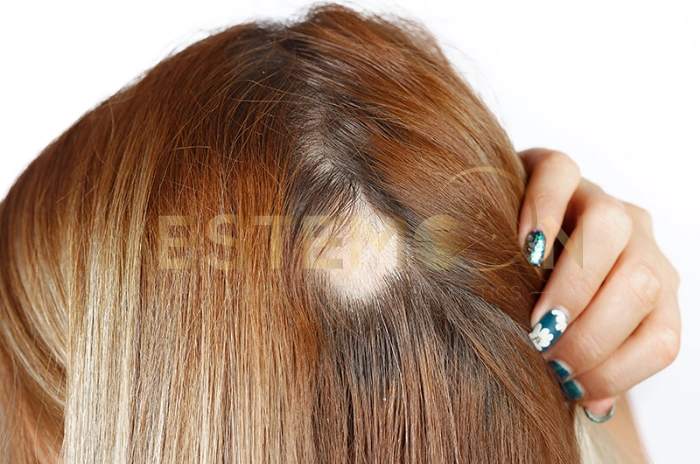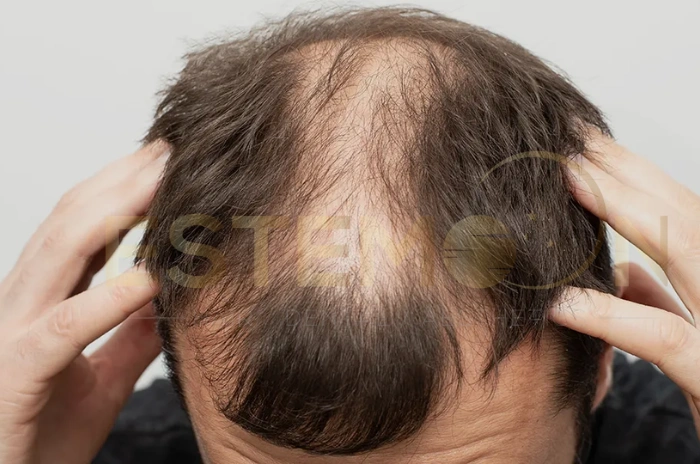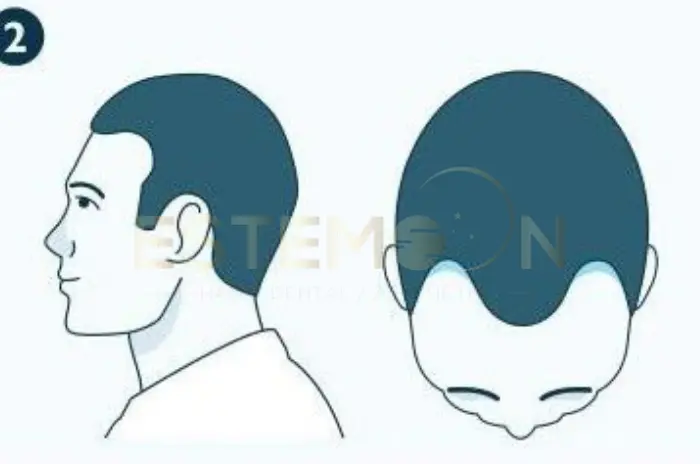Hair loss affects millions of people worldwide, causing not only physical changes but also emotional distress. While some hair shedding is normal, experiencing sudden hair loss causes or noticing signs of hair loss that seem excessive can be concerning. Many people wonder whether they should seek professional help or if their hair loss will resolve on its own.
A dermatologist for hair thinning plays a crucial role in diagnosing and treating various types of hair loss. These medical specialists understand the complex relationship between hair loss and skin conditions, offering both female hair loss treatment and male hair loss dermatologist services. Whether you’re dealing with gradual thinning or sudden patches of hair loss, getting a professional hair loss diagnosis can provide clarity and effective treatment options.
Understanding when to seek help and what to expect during a hair loss consultation can make the difference between managing your condition effectively and watching it progress unnecessarily. This comprehensive guide will help you recognize the warning signs and understand how dermatological expertise can restore both your hair and confidence.
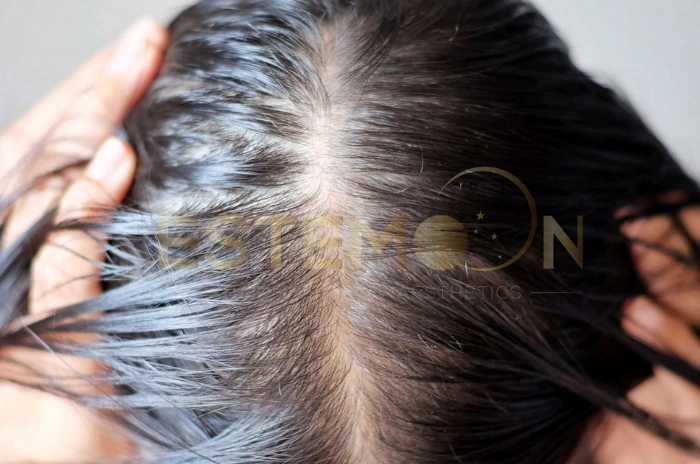
Signs It’s Time to See a Dermatologist for Hair Loss
Hair Falling Out More Than Usual
Most people lose 50-100 hairs daily as part of the normal hair growth cycle. However, if you notice significantly more hair in your brush, on your pillow, or in the shower drain, this could indicate an underlying issue. Hair thinning treatment becomes necessary when the hair loss exceeds normal shedding patterns.
Pay attention to changes in your daily hair loss. If you’re suddenly finding clumps of hair or noticing that your hairbrush collects much more hair than usual, these are clear signs of hair loss that warrant professional attention. A dermatologist for hair thinning can determine whether your increased shedding is temporary or requires intervention.
You Notice Bald Patches or Thinning Areas
Patchy hair loss is often one of the most obvious indicators that professional help is needed. Unlike gradual thinning, patches of complete hair loss or significantly thinned areas suggest specific conditions that require medical hair loss diagnosis. These patches may appear suddenly or develop gradually over time.
Female pattern hair loss and pattern baldness early signs in men often manifest as thinning at the crown or receding hairlines. A female hair loss dermatologist can distinguish between normal aging-related thinning and more serious conditions requiring treatment. Early intervention often leads to better outcomes.
Hair Loss Comes on Suddenly
Sudden hair loss causes can range from stress and hormonal changes to autoimmune conditions. When hair loss occurs rapidly over weeks or months rather than gradually over years, this typically indicates an acute condition that needs immediate attention. Telogen effluvium is one common cause of sudden, diffuse hair loss.
Sudden onset hair loss may also indicate Alopecia areata symptoms, where the immune system attacks hair follicles. A male hair loss dermatologist or specialist treating women can quickly identify these conditions and begin appropriate treatment to prevent further loss.
Your Scalp Feels Itchy, Painful, or Looks Inflamed
Scalp issues and hair loss often go hand in hand. An itchy red scalp accompanied by hair loss may indicate infections, inflammatory conditions, or allergic reactions. These symptoms require prompt evaluation as they can cause permanent damage to hair follicles if left untreated.
Inflammation, scaling, redness, or tenderness of the scalp are warning signs that shouldn’t be ignored. Hair loss and skin conditions affecting the scalp can worsen without proper treatment, making early intervention crucial for preserving remaining hair and preventing further damage.
How a Dermatologist Can Help With Hair Loss
Identifying the Underlying Cause
A professional hair loss diagnosis begins with identifying the specific type and cause of your hair loss. Dermatologists are trained to recognize various patterns and presentations of hair loss conditions. They can distinguish between Androgenetic alopecia, Telogen effluvium, and other conditions that may appear similar to untrained eyes.
During your hair loss consultation, the dermatologist will examine your scalp, review your medical history, and ask about recent life events, medications, and family history. This comprehensive approach helps identify whether your hair loss is genetic, hormonal, stress-related, or caused by underlying medical conditions.
Offering Medical Treatments and Lifestyle Advice
Once diagnosed, dermatologists can prescribe evidence-based treatments like minoxidil finasteride dermatologist-recommended therapies. These medications have proven effectiveness for specific types of hair loss when used appropriately under medical supervision. Female hair loss treatment options may differ from male treatments due to hormonal considerations.
Beyond medications, dermatologists provide valuable lifestyle advice that can support hair health. They may recommend dietary changes, stress management techniques, or modifications to hair care routines that could be contributing to hair loss. This holistic approach addresses both immediate treatment needs and long-term hair health.
Referring to Specialists When Needed
Some cases require collaboration with other specialists. Dermatologists may refer patients to endocrinologists for hormonal evaluations, rheumatologists for autoimmune conditions, or recommend a hair transplant dermatologist recommendation when surgical intervention is appropriate. This coordinated care ensures comprehensive treatment.
For complex cases involving multiple factors, dermatologists serve as the primary coordinator of care, ensuring all aspects of your hair loss are addressed. They maintain oversight of your treatment plan while incorporating input from other specialists as needed.
Common Conditions That Lead to Hair Loss
| Condition | Type of Hair Loss | Common Symptoms | Typical Onset | Treatment Approach |
|---|---|---|---|---|
| Androgenetic Alopecia | Gradual thinning | Receding hairline (men), crown thinning (women) | Gradual over years | Minoxidil finasteride dermatologist treatments |
| Telogen Effluvium | Diffuse shedding | Excessive hair fall, overall thinning | Sudden hair loss causes 2-4 months after trigger | Address underlying cause, supportive care |
| Alopecia Areata | Patchy hair loss | Round bald patches, itchy red scalp possible | Sudden onset | Corticosteroids, immunotherapy |
| Scalp Infections | Localized hair loss | Scaling, inflammation, itchy red scalp | Variable | Antifungal or antibiotic treatments |
| Nutritional Deficiency | Diffuse thinning | General hair weakness, brittle hair | Gradual | Blood tests for hair loss, nutritional supplements |
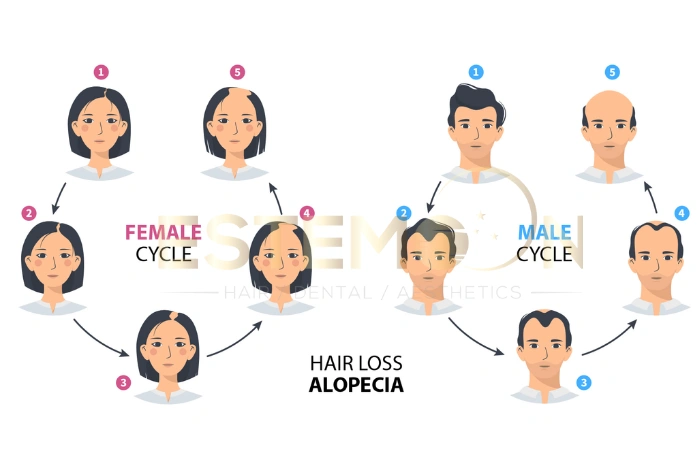
Androgenetic Alopecia (Male and Female Pattern Hair Loss)
Androgenetic alopecia is the most common cause of hair loss, affecting both men and women. This genetic condition causes hair follicles to gradually shrink over time, producing thinner and shorter hairs before eventually stopping hair production altogether. Pattern baldness early signs include recession at the temples in men and diffuse thinning at the crown in women.
Female pattern hair loss typically presents differently than male pattern baldness, with women experiencing diffuse thinning across the top of the scalp rather than distinct bald patches. A female hair loss dermatologist can confirm this diagnosis and recommend appropriate treatments like topical minoxidil or other approved therapies.
Telogen Effluvium from Stress or Illness
Telogen effluvium occurs when a significant number of hair follicles enter the resting phase simultaneously, leading to diffuse hair shedding several months later. Sudden hair loss causes related to this condition include severe stress, illness, surgery, rapid weight loss, or major life changes.
This condition is often temporary, but recovery can take several months. Understanding the timeline and triggers helps both patients and dermatologists develop appropriate treatment strategies and set realistic expectations for hair regrowth.
Alopecia Areata or Autoimmune Triggers
Alopecia areata symptoms include sudden appearance of round or oval patches of complete hair loss. This autoimmune condition causes the body’s immune system to attack hair follicles, resulting in patchy hair loss that can progress to total scalp hair loss or even body-wide hair loss in severe cases.
Early diagnosis and treatment of alopecia areata can sometimes prevent progression and encourage regrowth. Dermatologists may use blood tests for hair loss to rule out other autoimmune conditions and determine the best treatment approach for individual cases.
Scalp Infections and Skin Conditions
Various scalp issues and hair loss stem from fungal infections, bacterial infections, or inflammatory skin conditions. An itchy red scalp with scaling and hair loss may indicate seborrheic dermatitis, psoriasis, or fungal infections that require specific treatments.
These conditions can cause temporary or permanent hair loss depending on the severity and duration before treatment. Prompt diagnosis and appropriate antifungal or anti-inflammatory treatments can often restore hair growth and prevent scarring.
What to Expect During a Dermatology Visit
Medical History and Scalp Examination
Your first hair loss consultation will involve a comprehensive review of your medical history, including family history of hair loss, recent illnesses, medications, and lifestyle factors. The dermatologist will ask about the timeline of your hair loss, any associated symptoms, and previous treatments you may have tried.
The physical examination includes careful inspection of your scalp, hair pattern, and remaining hair quality. Dermatologists may use specialized tools like dermoscopy to examine hair follicles more closely and identify subtle signs that help with diagnosis.
Possible Tests and Diagnosis
Depending on your presentation, the dermatologist may recommend blood tests for hair loss to check for thyroid disorders, autoimmune conditions, nutritional deficiencies, or hormonal imbalances. These tests help identify treatable underlying causes that may be contributing to hair loss.
In some cases, a small scalp biopsy may be necessary to definitively diagnose certain conditions. This minor procedure provides detailed information about the hair follicles and surrounding tissue, helping guide treatment decisions for complex cases.
Personalized Hair Loss Treatment Plan
Following diagnosis, your dermatologist will develop a hair thinning treatment plan tailored to your specific condition, lifestyle, and treatment goals. This plan may include medications, lifestyle modifications, and follow-up schedules to monitor progress and adjust treatments as needed.
Treatment plans are individualized based on factors like age, sex, extent of hair loss, underlying causes, and patient preferences. Your dermatologist will explain expected timelines for improvement and potential side effects of recommended treatments.
How Dermatologists Diagnose Hair Loss
Scalp Examination and Medical History Review
A thorough professional hair loss diagnosis begins with examining the pattern and characteristics of your hair loss. Dermatologists look for specific patterns that indicate different conditions, such as the characteristic pattern of Androgenetic alopecia or the round patches typical of alopecia areata.
The examination includes assessing hair density, caliber, and distribution across different areas of the scalp. Dermatologists also examine the scalp skin for signs of inflammation, scaling, or scarring that might indicate underlying skin conditions affecting hair growth.
Tests and Procedures for Accurate Diagnosis
Beyond visual examination, dermatologists may perform specialized tests to confirm diagnoses. Blood tests for hair loss can reveal hormonal imbalances, autoimmune markers, or nutritional deficiencies that contribute to hair loss. These tests are particularly important for sudden or severe hair loss.
Pull tests, where the dermatologist gently tugs on hair to assess shedding patterns, help evaluate the severity and type of hair loss. Dermoscopy, a non-invasive examination using magnification, allows detailed visualization of hair follicles and scalp conditions.
Hair Loss Treatments Recommended by Dermatologists
Topical and Oral Medications
Minoxidil finasteride dermatologist-prescribed treatments remain the cornerstone of medical hair loss diagnosis and treatment. Minoxidil, available as a topical solution or foam, can be used by both men and women to stimulate hair growth and slow hair loss progression.
Finasteride, an oral medication primarily used for men, blocks the hormone responsible for Androgenetic alopecia. Women may be prescribed other hormonal treatments or anti-androgen medications depending on their specific situation and medical history.
Advanced Therapies and Lifestyle Advice
Modern dermatology offers advanced treatments beyond traditional medications. Low-level laser therapy, prescription-strength topical treatments, and specialized shampoos can complement primary treatments for enhanced results.
Lifestyle modifications play a crucial role in hair thinning treatment success. Dermatologists provide guidance on nutrition, stress management, gentle hair care practices, and avoiding damaging styling techniques that could worsen hair loss.
Advanced Treatments: PRP Therapy & Hair Transplantation
PRP therapy for hair loss involves using the patient’s own platelet-rich plasma to stimulate hair follicles and promote growth. This treatment shows promise for various types of hair loss and can be combined with other therapies for optimal results.
For advanced hair loss cases, dermatologists may provide a hair transplant dermatologist recommendation. While dermatologists don’t typically perform hair transplants themselves, they can evaluate candidacy and refer patients to qualified hair restoration surgeons when appropriate.
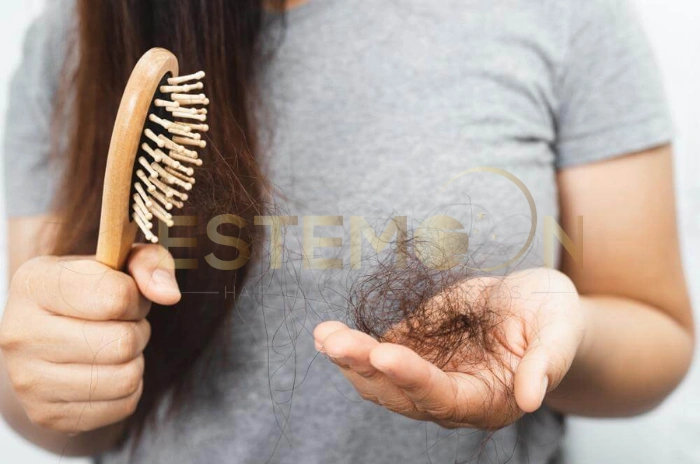
When Should You See a Dermatologist for Hair Loss?
Signs Your Hair Loss Needs Professional Attention
Signs of hair loss that warrant professional evaluation include sudden onset of hair loss, patchy hair loss, significant increase in daily hair shedding, or hair loss accompanied by scalp symptoms. Early intervention often leads to better treatment outcomes and can prevent progression.
If you notice pattern baldness early signs or have a family history of significant hair loss, consulting a dermatologist proactively can help establish baseline assessments and preventive treatment plans before extensive loss occurs.
Excessive Hair Shedding vs. Normal Hair Fall – How to Tell the Difference
Normal hair shedding involves losing 50-100 hairs daily, which may increase slightly during shampooing or brushing. Excessive shedding becomes apparent when you notice significantly more hair loss than usual, visible thinning, or hair collecting in unusual amounts.
A dermatologist for hair thinning can help you understand whether your hair loss is within normal limits or requires intervention. They can also teach you how to monitor your hair loss over time and recognize changes that might indicate progression.
Sudden Patchy Hair Loss – What It Could Mean
Sudden hair loss causes resulting in patches typically indicate Alopecia areata symptoms or other acute conditions requiring immediate attention. These patches may start small and expand rapidly, making early treatment crucial for the best outcomes.
Patchy hair loss can also result from trichotillomania (hair pulling), traction alopecia from tight hairstyles, or localized scalp infections. A medical hair loss diagnosis helps distinguish between these conditions and guide appropriate treatment strategies.
Is Hair Transplant an Option for You?
When Dermatologists Recommend Hair Transplant Surgery
Hair transplant surgery is typically considered for patients with stable Androgenetic alopecia who have not responded adequately to medical treatments. A hair transplant dermatologist recommendation usually comes after trying conventional therapies and ensuring the hair loss pattern has stabilized.
Candidates for hair transplant should have sufficient donor hair in the back and sides of the scalp, realistic expectations about results, and commitment to post-surgical care. Age, extent of hair loss, and overall health are important factors in determining candidacy.
Evaluating Your Candidacy for a Successful Hair Transplant
Dermatologists evaluate multiple factors when considering hair transplant dermatologist recommendation. These include the stability of your hair loss pattern, quality and quantity of donor hair, scalp characteristics, and your personal goals and expectations for the procedure.
The evaluation process includes assessing whether you might benefit from continued medical therapy, combination treatments, or if surgical intervention is the most appropriate next step. This comprehensive approach ensures optimal outcomes for patients considering hair restoration surgery.
FAQs About How a Dermatologist Can Help With Hair Loss – Causes and Treatments
What are the key signs that indicate it’s time to consult a dermatologist for hair loss?
Key signs of hair loss include excessive daily shedding beyond 100 hairs, sudden appearance of bald patches, gradual thinning that becomes noticeable, itchy red scalp with hair loss, or sudden hair loss causes following illness or stress.
How can a dermatologist help in diagnosing the cause of my hair loss?
A dermatologist provides professional hair loss diagnosis through comprehensive scalp examination, medical history review, blood tests for hair loss when indicated, and specialized tests to identify the specific type and underlying causes of your condition.
What are some common medical conditions that a dermatologist might identify as the cause of hair loss?
Common conditions include Androgenetic alopecia (genetic hair loss), Telogen effluvium from stress or illness, Alopecia areata symptoms (autoimmune hair loss), thyroid disorders, hormonal imbalances, and various scalp issues and hair loss from infections or inflammation.
What should I expect during my first visit to a dermatologist for hair loss?
Your hair loss consultation will include detailed medical history discussion, thorough scalp examination, assessment of hair loss patterns, possible blood tests for hair loss, and development of a personalized treatment plan based on your specific diagnosis and needs.
What types of treatments do dermatologists typically recommend for hair loss?
Hair thinning treatment options include minoxidil finasteride dermatologist-prescribed medications, topical treatments, PRP therapy for hair loss, lifestyle modifications, specialized shampoos, and in appropriate cases, hair transplant dermatologist recommendation for surgical options.
How can I differentiate between normal hair shedding and hair loss that requires professional attention?
Normal shedding involves 50-100 hairs daily, while concerning signs of hair loss include significantly increased shedding, visible thinning areas, patchy hair loss, or hair loss accompanied by scalp symptoms like itching or inflammation.
Can sudden, patchy hair loss be a sign of a serious condition, and when should I seek immediate help?
Sudden hair loss causes resulting in patches may indicate Alopecia areata symptoms, autoimmune conditions, or infections requiring prompt treatment; seek immediate help if accompanied by scalp pain, rapid progression, or systemic symptoms.
How long does it typically take to see results from dermatologist-prescribed hair loss treatments?
Most medical hair loss diagnosis and treatment plans require 3-6 months to show initial results, with full assessment typically occurring at 12 months, as hair growth cycles are naturally slow and treatments need time to influence follicle activity.
Follow us on social media for updates, tips, and patient success stories:

